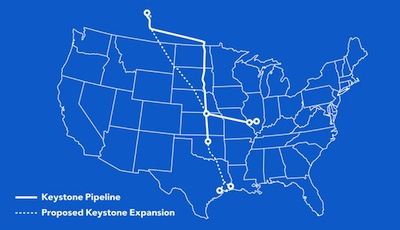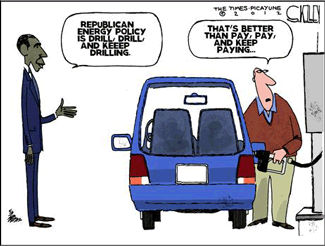TransCanada Touts Oil Pipeline from Okla. to Texas
Daily News Article — Posted on February 28, 2012

The solid line is the existing Keystone 1 pipeline; the dotted line is the proposed Keystone XL pipeline. TransCanada said it will build the portion from Oklahoma to Texas after President Obama blocked approval for the full pipeline (dotted line) from Canada into the U.S.
(by Matthew Daly, ElPasoTimes.com) WASHINGTON (AP) – A Canadian company said Monday it will build an oil pipeline from Oklahoma to Texas after President Barack Obama blocked the larger Keystone XL pipeline from Canada.
Calgary-based TransCanada says the new project does not require presidential approval, since it does not cross a U.S. border. The shorter pipeline is expected to cost about $2.3 billion and be completed next year, the company said. …
[White House] Press secretary Jay Carney said [President] Obama welcomed the announcement.“Moving oil from the Midwest to the world-class, state-of-the-art refineries on the Gulf Coast will modernize our infrastructure, create jobs, and encourage American energy production,” Carney said in a statement. “We look forward to working with TransCanada to ensure that it is built in a safe, responsible and timely manner, and we commit to take every step possible to expedite the necessary federal permits.
TransCanada said Monday it still hopes to build the full 1,700-mile Keystone XL pipeline, which would carry oil derived from tar sands in Alberta, Canada to refineries along the Texas Gulf Coast. The proposed $7 billion pipeline would run through Montana, South Dakota, Nebraska and Kansas before reaching Oklahoma. …..
Pipeline supporters – including congressional Republicans and many business and labor leaders— call the project a key job creator, while opponents say it would transport “dirty oil” that requires huge amounts of energy to extract. They also worry about a possible spill.
Carney said that Obama’s Jan. 18 decision “in no way prejudged future applications” by TransCanada for the full, 1,700-mile project.
“We will ensure any project receives the important assessment it deserves, and will base a decision to provide a permit on the completion of that review,” he said.
Russ Girling, TransCanada’s president and CEO, said the Oklahoma-to-Texas pipeline will transport growing supplies of U.S. crude oil to meet refinery demands in Texas.
“Gulf Coast refineries can then access lower cost domestic production and avoid paying a premium to foreign oil producers,” he said, adding that the project should reduce U.S. dependence on crude from outside North America.
Copyright © 2012, Associated Press. Reprinted here for educational purposes only. May not be reproduced on other websites without permission from the El Paso Times. Visit the website at ElPasoTimes.com.
Background
TransCanada Keystone XL Pipeline:
(From studentnewsdaily.com/daily-news-article/vast-network-of-pipelines-already-in-place-in-u-s)
- The Obama administration on January 18th blocked a permit for the $7 billion Keystone XL, at least temporarily, claiming a more thorough review is needed to examine problems it may pose to the nation’s air and water quality. The administration also blamed Republicans for including a provision in a recent tax cut bill that compelled a decision within a 60-day time frame.
- The pipeline system, proposed by the Canadian firm TransCanada, would transport crude oil from the Athabasca Oil Sands in northeastern Alberta [Canada] to multiple locations in the U.S., including as far as the Gulf Coast of Texas. The Keystone XL would go through Montana, South Dakota, Nebraska, Kansas and Oklahoma, and the so-called “feeder pipelines” would connect it to rich oil fields in North Dakota and Montana.
- The U.S. State Department has expressed concerns over the pipeline’s environmental impact, particularly in the Nebraska Sandhills, an area of porous hills that includes a high concentration of wetlands and a key aquifer.
- Environmental activist groups claim the pipeline system could pollute air and water supplies as well as harm fragile ecosystems. The original route also called for the pipeline to cross the Ogallala Aquifer, one of the world’s largest aquifers that extends into eight states and provides drinking water for two million people.
- While the Obama administration says it needs more time to assess the potential risks surrounding the proposed Keystone XL pipeline, a vast underground network of more than 2 million miles of energy pipeline already traverses the United States.
- Several energy experts who represent the oil and gas industry say the controversial Keystone XL, a 1,700-mile pipeline that would run from Canada to Texas, poses less of a risk to the environment than the estimated 50,000 miles of crude oil pipelines already crisscrossing the U.S., a network they say is safe and efficient.
Cartoon by Steve Kelley:

